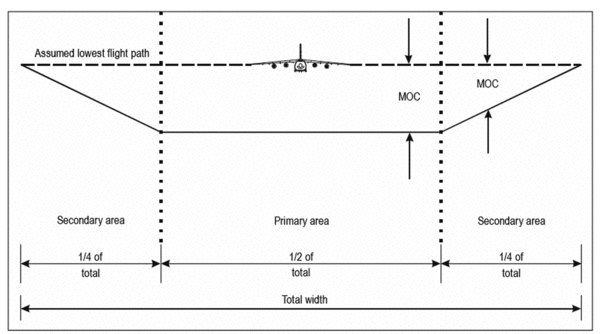For the purpose of take-off performance analysis, the end of take-off flight path is considered to be when airplane reaches at least one of:
* A Fix and minimum altitude from which an approach may be initiated back to the departure airport or from which it is possible to proceed to departure alternate
* MSA
* Minimum en-route altitude for a route to departure alternate
* Minimum Radar Vectoring Altitude
An engine out take-off flight path and obstacle analysis method is based on AFM Net flight path, which clears all obstacles by 35 ft vertically and OPS 1 obstacle assessment area, centered on the intended flight track, within which all obstacles must be cleared vertically.
Development of contingency procedures, required to cover the case of engine failure or an emergency in flight which occurs after V1, is the responsibility of the operator, in accordance with Annex 6. Where terrain and obstacles permit, these procedures should follow the normal departure route.
When it is necessary to develop a turning procedure to avoid an obstacle which would have become limiting, then the procedure should be described in detail in the appropriate operator's manual. The point for start of turn in this procedure must be readily identifiable by the pilot when flying under instrument conditions.
The minimum obstacle clearance equals zero at the departure end of runway (DER). From that point, it increased by 0.8 per cent of the horizontal distance in the direction of flight assuming a maximum turn of 15°. In the turn initiation area and turn area, a minimum obstacle clearance of 90 m (295 ft) is provided. Where precipitous and mountainous terrain exist, consideration is given to increasing the minimum obstacle clearance.
The procedure design gradient (PDG) is intended as an aid to adjust the route with the intention of minimizing the PDG consistent with other constraints. Unless otherwise published, a PDG of 3.3 per cent is assumed. The PDG is not intended as an operational limitation for those operators who assess departure obstacles in relation to aircraft performance, taking into account the availability of appropriate ground/airborne equipment.
The PDG is based on:
a. an obstacle identification surface (OIS) having a 2.5 per cent gradient or a gradient determined by the most critical obstacle penetrating the surface, whichever is the higher; and
b. an additional margin of 0.8 per cent.
Published gradients are specified to an altitude/height after which the minimum gradient of 3.3 per cent is considered to prevail. The final PDG continues until obstacle clearance is ensured for the next phase of flight (i.e. en-route, holding or approach). At this point, the departure procedure ends and is marked by a significant point.
Whenever a suitably located DME exists, additional specific height/distance information intended for obstacle avoidance may be published. RNAV waypoint or other suitable fixes may be used to provide a means of monitoring climb performance.




